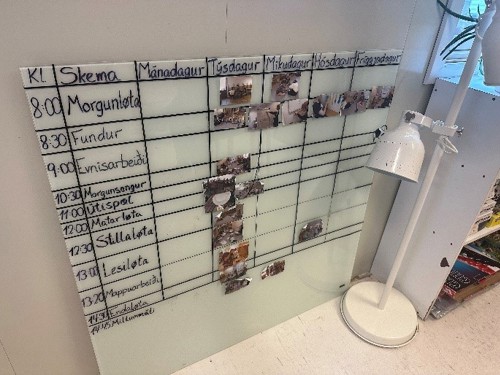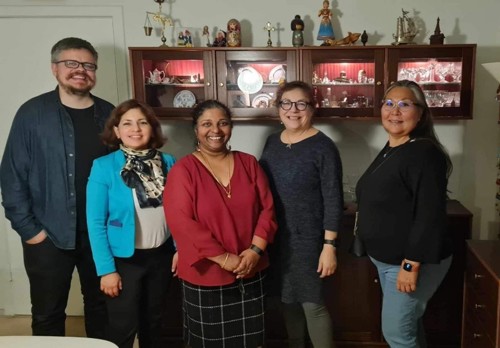Blog: From Alaska to the "navel of the world"- The Faroe Islands

Diane Hirshberg, director of the Institute of Social and Economic Research at the University of Alaska Anchorage (UAA), and Panigkaq Agatha John Shields, Assistant Professor of Indigenizing Education in the School of Education at UAA traveled to the Faroe Islands in October to learn about the education system in the Faroes and postsecondary education for teachers.
They were hosted by Kalpana Vijayavarathan, Associate Professor in English and English Language Teaching at the University of the Faroe Islands, and Knút Háberg Eysturstein, a doctoral student in music education in the Faculty of Education, University of the Faroe Islands.
Our visit started with meeting with the head of the Faculty of Education, and an overview of the teacher education programs at the university. Next we had our first school visit, to the Lokin (School) in Eysturoy.
Just driving to the school was exciting as we traveled through the Eysturoy Tunnel, which connects the connecting the island of Streymoy to the island of Eysturoy. The tunnel features the world's first undersea roundabout, which is ringed in art. Lokin is a lower secondary school in a relatively new building (as were many of the schools we visited). At the school we observed a lot of robotics and technology learning opportunities, as well as a beautiful wood shop classroom, and beautiful flexible learning spaces.
In the afternoon we visited the Glasir upper secondary school, which was an impressive school. A five story circular building built around a large atrium, the school features a broad array of career and technical learning opportunities from fully equipped beauticians space to advanced science labs to a fashion design space including advanced sewing machines, a high tech automotive repair and machining shop, and many cases of skulls, bones, and stuffed birds for biology and anthropology courses. We observed a music class featuring a full rock band in a band rehearsal space that also included sophisticated recording technology. There also was a lot of attention to multicultural issues as well as a “banned books” exhibit in the library.
After seeing Glasir we went out to Streymoy to see the village of Kirkjubøur, one of the most important historic sites in the Faroe Islands and the location of the remains of Magnus Cathedral (which was built in the 13th century but never completed, as well as the Saint Olav’s Church (Olavskirkjan), and a log house called Roykstovan, both of which were built in the 1100s. We went for a walk along the coast and saw sheep eating seaweed on the beach!

The following day we started with a meeting with the University of the Faroe Islands Rector Martin Zachariassen. We had an interesting overview of both how the university had grown and the plans for the future which include new buildings and programs.
After lunch we met with Annika Sólvára, the Head of the Faroese Research Council, and learned about research funding and priorities for the Faroe Islands.
We spent one day at the 16th Polar Law Symposium, which happened to coincide with our visit to the Faroe Islands. After hearing a Frederick Harhoff give a keynote address on Greenland’s shifting political alliances we listened to presentations on whether UNDRIP can help actualize Inuit self-determination in Nunavut, on challenges for Indigenous People’s human rights from the green shift, on Arctic governance issues, on Indigenous language rights in Russia, and many other interesting topics.
We had dinner with the Rector and the Vice Rector Research, and had an extensive discussion about opportunities for cooperation both through UArctic and directly between UAA and UofFI.

On Thursday, we attended the Polar Law Symposium which happened to be meeting in the Faroe Islands at the same time as our visit. We were excited to hear talks about everything from Indigenous language revitalization to geopolitical positioning in Greenland and to meet with academics from across the Arctic.
We began Friday with the students and faculty from the education programs, and were treated to (and participated in) traditional (and not so traditional) communal Faroese singing and dancing. It was a truly lovely experience and a window into Faroese culture.
We then visited the Skúlin Á Fløtum school which serves children in grades 1-9. This school is in a new, state-of-the-art building divided into three “houses” for grades 1-3, 4-6, and 7-9. It has many innovative learning spaces and lots of art, including a beautiful “literacy horse” made from plexiglass letters as a centerpiece in the library.

The building was designed with many intentional features such as the ability from the top to see down through the whole building, but from the bottom not to be able to see all of the spaces – to metaphorically allow the older children to look back at where they’ve come from, but not to allow the younger children to know fully where they are headed. One thing that struck us was that the school day seemed relatively short, and as we were leaving the building before noon we noticed the younger children heading out as well.
In the afternoon we drove back out to Streymoy to see an independent school named Friskúlin. Located in a converted house, the school is run by a transplanted American and operates on Deweyan principles, with students engaging in a diverse array of hands-on learning activities. It was interesting to learn that while most students on the islands are educated in public schools, there are a couple of alternative options similar to charter schools.


We were treated to a lovely dinner that night by Kalpana and her husband Viji, where we learned more about life in the Faroe Islands and the growing diversity of the community.

Over the weekend we explored the National Gallery of the Faroe Islands as well as the National Museum of the Faroe Islands and had fun in the best thrift shop on the islands. We also saw some more of the natural (and windy) beauty of the outdoor environment.


